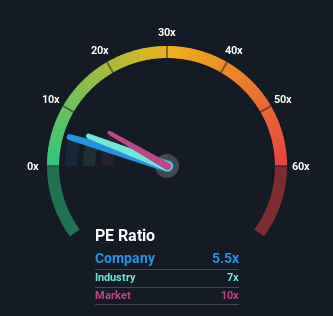- Canada
- /
- Real Estate
- /
- TSXV:NXLV
Investors Don't See Light At End Of NexLiving Communities Inc.'s (CVE:NXLV) Tunnel
With a price-to-earnings (or "P/E") ratio of 5.5x NexLiving Communities Inc. (CVE:NXLV) may be sending bullish signals at the moment, given that almost half of all companies in Canada have P/E ratios greater than 10x and even P/E's higher than 24x are not unusual. However, the P/E might be low for a reason and it requires further investigation to determine if it's justified.
NexLiving Communities hasn't been tracking well recently as its declining earnings compare poorly to other companies, which have seen some growth on average. The P/E is probably low because investors think this poor earnings performance isn't going to get any better. If this is the case, then existing shareholders will probably struggle to get excited about the future direction of the share price.
View our latest analysis for NexLiving Communities

What Are Growth Metrics Telling Us About The Low P/E?
In order to justify its P/E ratio, NexLiving Communities would need to produce sluggish growth that's trailing the market.
Retrospectively, the last year delivered a frustrating 7.0% decrease to the company's bottom line. This has erased any of its gains during the last three years, with practically no change in EPS being achieved in total. Therefore, it's fair to say that earnings growth has been inconsistent recently for the company.
Turning to the outlook, the next year should bring diminished returns, with earnings decreasing 100% as estimated by the three analysts watching the company. Meanwhile, the broader market is forecast to expand by 10%, which paints a poor picture.
With this information, we are not surprised that NexLiving Communities is trading at a P/E lower than the market. However, shrinking earnings are unlikely to lead to a stable P/E over the longer term. Even just maintaining these prices could be difficult to achieve as the weak outlook is weighing down the shares.
The Final Word
Using the price-to-earnings ratio alone to determine if you should sell your stock isn't sensible, however it can be a practical guide to the company's future prospects.
As we suspected, our examination of NexLiving Communities' analyst forecasts revealed that its outlook for shrinking earnings is contributing to its low P/E. At this stage investors feel the potential for an improvement in earnings isn't great enough to justify a higher P/E ratio. It's hard to see the share price rising strongly in the near future under these circumstances.
It's always necessary to consider the ever-present spectre of investment risk. We've identified 5 warning signs with NexLiving Communities (at least 3 which are a bit unpleasant), and understanding them should be part of your investment process.
If you're unsure about the strength of NexLiving Communities' business, why not explore our interactive list of stocks with solid business fundamentals for some other companies you may have missed.
Valuation is complex, but we're here to simplify it.
Discover if NexLiving Communities might be undervalued or overvalued with our detailed analysis, featuring fair value estimates, potential risks, dividends, insider trades, and its financial condition.
Access Free AnalysisHave feedback on this article? Concerned about the content? Get in touch with us directly. Alternatively, email editorial-team (at) simplywallst.com.
This article by Simply Wall St is general in nature. We provide commentary based on historical data and analyst forecasts only using an unbiased methodology and our articles are not intended to be financial advice. It does not constitute a recommendation to buy or sell any stock, and does not take account of your objectives, or your financial situation. We aim to bring you long-term focused analysis driven by fundamental data. Note that our analysis may not factor in the latest price-sensitive company announcements or qualitative material. Simply Wall St has no position in any stocks mentioned.
About TSXV:NXLV
NexLiving Communities
Owns and manages multi-unit residential real estate properties in Canada.
Proven track record with low risk.
Market Insights
Community Narratives


Recently Updated Narratives


MINISO's fair value is projected at 26.69 with an anticipated PE ratio shift of 20x


The Quiet Giant That Became AI’s Power Grid


Nova Ljubljanska Banka d.d will expect a 11.2% revenue boost driving future growth
Popular Narratives


The company that turned a verb into a global necessity and basically runs the modern internet, digital ads, smartphones, maps, and AI.


MicroVision will explode future revenue by 380.37% with a vision towards success



